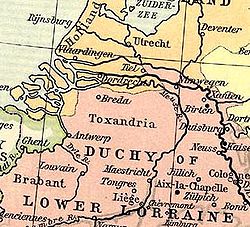Texandria
Ancient and Medieval region of the Netherland and Belgium From Wikipedia, the free encyclopedia
Texandria (also Toxiandria; later Toxandria, Taxandria),[note 1] is a region mentioned in the 4th century AD and during the Middle Ages. It was situated in the southern part of the modern Netherlands and in the northern part of present-day Belgium, an area currently known as Campine (Kempen in Dutch).
Name
The tribal name Texandri, which may be related to the name of the region,[1] is mentioned as Texand(ri) by an inscription dated 100–225 AD, as Texuandri by Pliny (1st c. AD),[2] and perhaps as Texu<...> on an inscription from Romania dated 102–103 AD.[3]
The variant form Toxiandria is only attested once in a 9th-century manuscript of Ammianus Marcellinus' Res Gestae (ca. 390) to designate the region, and the variant Taxandria occurs five times in 9th-century sources, and also in later documents.[3] The inconsistencies in spelling may be explained by dittography (errors by copyists), or by the fact that the older form Texandria had fallen out of usage.[3][4]
The name Texandria is generally assumed to derive from the Proto-Germanic stem *tehswō(n)- ('right [hand], south'; cf. Old Saxon tesewa, Gothic taihswa, 'right, south') attached to the contrasting suffix *-dra-.[5][6][1] Texandria may thus be interpreted as the 'land of the southerners'.[1]
History
Summarize
Perspective
The region of Texandria is first mentioned by the Roman historian Ammianus Marcellinus ca. 390 AD.[4] In the 380s, the Salian Franks, after being defeated by Julian ca. 358, were given permission to settle apud Toxiandriam locum ('at a place in Toxiandria').[7]

Between 709 and ca. 1100, the name Texandria was used to designate an area in the modern region of Campine, straddling southern Netherlands and northern Belgium. In sources of the period 709–795, the pagus Texandrie appears concentrated in the basin of the river Dommel and its tributaries, with a first cluster of settlement between Alphen in the west and Waalre in the east, and a second cluster to the south around Overpelt.[7]
As a result of a growing elite network of alliances, Texandria expanded between 815 and 914 to a region covering modern North Brabant and adjacent parts of the provinces of Antwerp and Limburg (possibly between Oosterhout, Laakdal and Reppel).[8] In the mid-11th century, Stepelinus, a monk from Saint-Trond, located the region of Campania (firstly attested in this document) within Texandria.[9] From ca. 1225, Campania (modern Campine) replaced Texandria as the name of the region. The later had nonetheless survived as the name of a vast archdeaconry within the diocese of Liège, although it was eventually also replaced with Campania by the end of the 14th century, then disappeared from historical records.[10][note 2]
References
Wikiwand - on
Seamless Wikipedia browsing. On steroids.